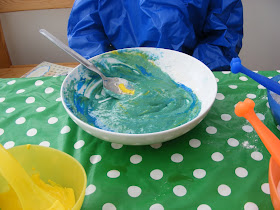Whilst at our Agricultural Show at the weekend I attended a Victoria Sandwich Cake Masterclass. This wasn't a demonstration but rather advice on what judges are looking for when awarding prizes in cake competitions. I thought I'd share these tips and also a recipe for anyone who might be interested. Of course I enlisted the help of my two mini bakers too!
A true Victoria Sandwich is sandwiched together with raspberry jam only (no buttercream) and has a sprinkling of caster sugar (not icing sugar). Using butter is preferable to baking margarine (although I won third prize a couple of years back using Stork!). Use good quality ingredients, fresh butter and eggs. Ensure there is no jam running down the sides and take care not to put your cake in too hot an oven for too long. It should be light golden yellow on top when cooked. A Victoria Sandwich should always be baked in two tins not a single tin and then cut in half.
Here's our recipe. Grease two 20cm sandwich tins and line the base with baking paper. Then weigh four medium sized eggs and make a note of the weight. Ours were 232g. Then use this weight to measure the same quantity of butter (softened, left out of the fridge for a while first), caster sugar, and self raising flour.
Use either an electric whisk or a wooden spoon to cream the butter and sugar until it is light and fluffy in texture.
Then add the eggs one at a time and beat into the mixture.
Then fold in the flour using a metal spoon. do this a couple of spoonfuls at a time mixing gently until all the flour is combined.
Then carefully spoon equal amounts into the tins and smooth the surface.
Bake in the oven at 180 degrees (or less if you have a fan assisted oven) for about 20 mins.
Allow to cool a little in the tins before turning out onto a cooling rack. Be careful not to get cooling rack marks on the top of the cake - this will lose you points apparently! Once cool, warm some raspberry jam.
Spread over the top of one of the cakes and then sandwich together.
Dredge the top with caster sugar and you're done!
A true Victoria Sandwich is sandwiched together with raspberry jam only (no buttercream) and has a sprinkling of caster sugar (not icing sugar). Using butter is preferable to baking margarine (although I won third prize a couple of years back using Stork!). Use good quality ingredients, fresh butter and eggs. Ensure there is no jam running down the sides and take care not to put your cake in too hot an oven for too long. It should be light golden yellow on top when cooked. A Victoria Sandwich should always be baked in two tins not a single tin and then cut in half.
Here's our recipe. Grease two 20cm sandwich tins and line the base with baking paper. Then weigh four medium sized eggs and make a note of the weight. Ours were 232g. Then use this weight to measure the same quantity of butter (softened, left out of the fridge for a while first), caster sugar, and self raising flour.
Use either an electric whisk or a wooden spoon to cream the butter and sugar until it is light and fluffy in texture.
Then add the eggs one at a time and beat into the mixture.
Then fold in the flour using a metal spoon. do this a couple of spoonfuls at a time mixing gently until all the flour is combined.
Then carefully spoon equal amounts into the tins and smooth the surface.
Bake in the oven at 180 degrees (or less if you have a fan assisted oven) for about 20 mins.
Allow to cool a little in the tins before turning out onto a cooling rack. Be careful not to get cooling rack marks on the top of the cake - this will lose you points apparently! Once cool, warm some raspberry jam.
Spread over the top of one of the cakes and then sandwich together.
Dredge the top with caster sugar and you're done!






















































